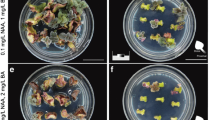Abstract
Suspension cultures from Arabidopsis thaliana wild type and AtPIN1-deficient lines were initiated and maintained for more than 3 years. A protocol for efficient regeneration from long-term suspension cultures was established. Arabidopsis wild-type and respectively AtPIN1 mutant plants have been regenerated from these cultures and characterized. Additionally, transgenic suspension cultures expressing the uidA (β -glucuronidase) reporter gene under the control of AtPIN1 promoter have been used for morphogenic studies. Our studies suggest that a lack of AtPIN1 function affects shoot differentiation and development, but does not influence in vitro regeneration of plants.
Similar content being viewed by others
References
Benkova E, Michniewicz M, Sauer M, Teichmann T, Seifertova D, Jürgens G & Friml J (2003) Local, efflux-dependent auxin gradients as a common module for plant organ formation. Cell 115: 591–602
Bennett SRM, Alvarez J, Bossinger G & Smyth DR (1995) Morphogenesis in pinoid mutants of Arabidopsis thaliana. Plant J. 8: 505–520
Delbarre A, Müller P, Imhoff V & Guern J (1996) Comparison of mechanisms controlling uptake and accumulation of 2,4-dichlorophenoxy acetic acid, naphtalene-1-acetic acid and indole-3-acetic acid in suspension-cultured tobacco cells. Planta 198: 532–541
De Vries SC, Booij H, Meyerink P, Huisman G, Wilde HD, Thomas TL & Van Kammen A (1988) Acquisition of embryogenic potential in carrot cell-suspensions cultures. Planta 176: 196–204
Feher A, Pasternak TP & Dudits D (2003) Transition of somatic plant cells to an embryogenic state. Plant Cell Tiss. Org. Cul. 74: 201–228
Friml J, Benkova E, Mayer U, Palme K & Muster G (2003) Automated whole mount localisation techniques for plant seedlings. Plant J. 34: 115–124
Imhoff V, Müller P, Guern J & Delbarre A (2000) Inhibitors of the carrier-mediated influx of auxin in suspension-cultured tobacco cells. Planta 210: 580–588
Gälweiler L, Guan C, Müller A, Wisman E, Mendgen K, Yephremov A & Palme K (1998) Regulation of polar auxin transport by AtPIN1 in Arabidopsis vascular tissue. Science 282: 2226–2230
Gamborg OL, Miller RA & Ojima K(1968) Nutrient requirements of suspension cultures of soybeen root cells. Exp. Cell Res. 50: 151–158
Hensel G, Kunze G & Kunze I (2002) The influence of 2,4-dichlorphenoxyacetic acid on localisation of the PR-proteins CBP20 and class I chitinase in tobacco suspension cell culture. Plant Science 163: 1099–1106
Mathur J, Szabados L, Schaefer S, Grunenberg B, Lossow A, Jonasstraube E, Schell J, Koncz C & Koncz-Kalman Z (1998) Gene identification with sequenced T-DNA tags generated by transformation of Arabidopsis cell suspension. Plant J. 13: 707–716
Meijer EA, de Vries SC & Mordhorst AP (1999) Co-culture with Daucus carota somatic embryos reveals high 2,4-D uptake and release rates of Arabidopsis thaliana cultured cells Plant Cell Rep. 18: 656–663
Michalczuk L, Cooke TJ & Choen JD (1992a) Auxin levels at different stages of carrot somatic embryogenesis. Phytochemistry 31: 1097–1103
Michalczuk L, Ribnicky V, Cooke TJ & Choen JD (1992b) Regulation of indole-3-acetic acid biosynthetic pathways in carrot cell cultures. Plant Physiol. 100: 1346–1353
Mordhorst AP, Hartog MV, El Tamer MK, Laux T & de Vries SC (2002) Somatic embryogenesis from Arabidopsis shoot apical meristem mutants. Planta 214: 829–836
Murashige T & Skoog F (1962) A revised medium for rapid growth and bioassays with tobacco tissue cultures. Physiol. Plant 15: 473–497
Nakano M, Sakakibara T, Suzuki S & Saito H (2000) Decrease in the regeneration potential of long term cell suspension cultures of Lilium formosanum Wallace and its restoration by the auxin transport inhibitor 2,3,5-triiodbenzoic acid. Plant Sci. 158: 129–137
Okada K, Ueda J, Komaki MK, Bell CJ & Shimura Y (1991) Requirement of the auxin polar transport system in early stages of Arabidopsis floral bud formation. Plant Cell 3: 677–684
Reinhardt D, Pesce ER, Stieger P, Mandel T, Baltensperger K, Bennett M, Traas J, Friml J, Kuhlemeier C (2003) Regulation of phyllotaxis by polar auxin transport. Nature 426: 255–260
Ribeiro RCS, Jekkel Z, Mulligan BJ, Cocking EC, Power JB, Davey MR & Lynch PT (1996) Regeneration of fertile plants from cryopreserved cell suspensions of Arabidopsis thaliana (L.) Heynh. Plant Sci. 115: 115–121
Sabatini S, Beis D, Wolkenfelt H, Murfett J, Guilfoyle T, Malamy J, Benfey P, Leyser O, Bechtold N, Weisbeek P & Scheres B (1999) An auxin-dependent distal organizer of pattern and polarity in the Arabidopsis root. Cell 99: 463–472
Sieberer T, Hauser MT, Seifert GJ & Luschnig C (2003) PROPORZ1, a putative Arabidopsis transcriptional adaptor protein, mediates auxin and cytokinin signals in the control of cell proliferation. Curr. Biol. 13: 837–842
Zuo JR, Niu QW, Frugis G & Chua NH (2002) The WUSCHEL gene promotes vegetative-to-embryonic transition in Arabidopsis. Plant J. 30: 349–359
Author information
Authors and Affiliations
Corresponding author
Rights and permissions
About this article
Cite this article
Eneva, T., Tietz, O., Luley, E. et al. Loss of AtPIN1 does not influence the in vitro morphogenic potential of Arabidopsis thaliana suspension cultures. Plant Cell, Tissue and Organ Culture 79, 181–188 (2004). https://doi.org/10.1007/s11240-004-0658-8
Issue Date:
DOI: https://doi.org/10.1007/s11240-004-0658-8




